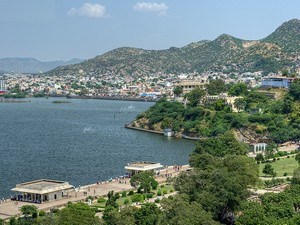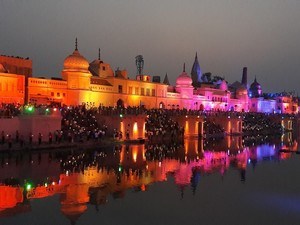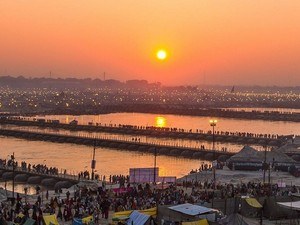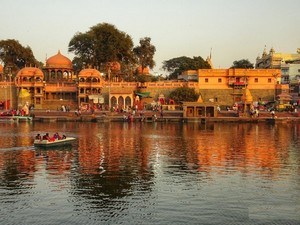1
DAY 1 : TRAVEL TO MANTRALAYAM & SIGHTSEEING
DAY 1 : TRAVEL TO MANTRALAYAM & SIGHTSEEING
 Sightseeing
Sightseeing
Leisure / No Sightseeing
At a distance of 1 Km from Mantralayam Bus Station, Samadhi Temple is the place where Raghavendra Swamy entered alive into Jeeva Samadhi (tomb), also called Brundavan. Samadhi Temple is the prime place to visit in Mantralayam, The Guru attained Samadhi in 1671 AD.
The main shrine is situated in a large builing inside the sprawling temple complex. The building has large verandah inside with administrative blocks and Samadhi temple at the center of the building. The main shrine has large hall with queue lines and inner sanctum housing Brundavan of Guru Raghavendra.
Devotees visiting Mantralaya believe that the Saint still exists in his holy form after he had relinquished the material world and that he will continue to dwell in this form till the completion of 700 years from the time he attained 'Jeeva Samathi'. The male devotees who want to perform Pooja themselves at Brundavan have to wear dhoti. While male devotees paying normal .....
 Duration of visit: 1-2 Hours
Duration of visit: 1-2 Hours
 Timings: 6 AM to 8:30 AM, 9:30 AM to 2 PM & 4 PM to 9.30 PM
Timings: 6 AM to 8:30 AM, 9:30 AM to 2 PM & 4 PM to 9.30 PM
BREAK FOR MEALS / HOTEL CHECK-IN | CHECK-OUT / SHOPPING / LEISURE
At a distance of 1 Kms from Mantralayam Bus Station, Manchalamma Temple is situated on northern-west corner of Sri Raghavendra Brundavan Temple building, towards the right side of the entrance. After Samadhi Temple, this is the most important place to visit in Mantralayam town. This deity is another manifestation of Goddess Parvathi. It is a practice for people to worship at this shrine before proceeding to Sri Raghavendra Brindavan.
Mantralayam was earlier known as Manchali, which was named after the deity Manchalamma worshipped here. Legend has it that Raghavendra Swamy requested the land required for the Brundavan Temple in Mantralaya from Manchalamma and hence devotees are first supposed to visit the Manchalamma temple before visiting Sri Raghavendra Swamy Temple.
The Manchalamma Temple has a hall with sanctum built in the form of a mini temple with vimana. The colorful vimana is decorated with several figures of goddress .....
 Duration of visit: 15 Mins
Duration of visit: 15 Mins
 Timings: 6 AM to 8:30 AM, 9:30 AM to 2 PM & 4 PM to 9.30 PM
Timings: 6 AM to 8:30 AM, 9:30 AM to 2 PM & 4 PM to 9.30 PM
2
DAY 2 : VISIT ALAMPUR & TRAVEL TO BANGALOREE
%%Itinerary_Title_Day2%%
 Sightseeing
Sightseeing
At a distance of 1 km from Alampur Bus Station, Kudala Sangameswara Temple is the most magnificent of the temples at Alampur. It was built in 740 AD by Chalukya ruler Pulakesi II.
The temple was originally located at the point where Tungabhadra and Krishna Rivers were merged, 10 kms away from the current site. The temple was dismantled and built exactly rock-to-rock in the current site in 1979, as the original site was getting submerged due to the construction of Srisailam Dam.
The Sangameswara Temple is a wonderful structure with beautiful carvings on all corners. Built in Nagara style, the temple is built on an elevated platform with fortified wall around the temple. The temple has got large hall with 12 pillars followed by the sanctum. There is a circumambulatory path around the sanctum for pradakshinas. The ceiling has a large relief of Nagaraja, as seen in other .....
 Duration of visit: 30 Mins
Duration of visit: 30 Mins
 Timings: 8 AM to 6 PM
Timings: 8 AM to 6 PM
At a distance of 2 kms from Alampur Bus Station, Papanasi Temples are a group of wonderful temples dedicated to Lord Shiva. These temples are known for beautiful carvings.
Originally built on the banks of Tungabhadra River, the temples were moved to the current location during the construction of Srisailam Dam. The group of 24 temples were developed between 6th and 10th centuries. The main shrine called Papanaseswara was built by Chalukyas in the 6th century while the remaining temples were constructed by Rashtrakutas between 9th and 10th centuries. Built in Dravida and Phamsana styles, the site has two main temples and remaining are sub-shrines.
The main shrine of Papanaseswara has a large pillared mandapa and sanctum with Shivalinga. There are sub-shrines of Ganesha and Saptamatrukas on each side. The important art work in this temple includes Vamana avatara, Ashtadikpalakas, Mahishasura Mardhini, Ramayana scenes, .....
 Duration of visit: 30 Mins
Duration of visit: 30 Mins
 Timings: 8 AM to 6 PM
Timings: 8 AM to 6 PM
At a distance of 1 km from Alampur Bus Station, Bala Brahma Temple or Bala Brahmeswara Temple near Jogulamba Temple is the largest and most striking temple of the Navabrahma group of temples. This is the only temple where majority of the sculptures are found in good shape.
Built in 7th century by Chalukya ruler Pulakesi II, the temple had several additions during Vikramadita period in 755 AD. Constructed in Nagara style, there temple has large pillared varandah on all sides for outer pradakshinas. The temple has large mukha mandapa, mahamandapa and sanctum with circumambulatory path for inner pradakshinas. The shivalinga in this shrine is seen in the shape of a bull's footprint.
The doorway of inner sanctum has Dwarapalakas, Lion images along with Goddess Lakshmi, Ardhanareeswara, Vinayaka, Kalabhairava, etc. The inner mandapa has engraved figures of Mahishasura mardhini, Saptamatrukas, Indra and Agni along with a large dancing Shiva on the ceiling. The pillar has Yogamurthi .....
 Duration of visit: 30 Mins
Duration of visit: 30 Mins
 Timings: 8 AM - 1 PM & 3 PM - 8 PM
Timings: 8 AM - 1 PM & 3 PM - 8 PM
At a distance of 1 km from Alampur Bus Station, Garuda Brahma Temple is situated towards southern side of Bala Brahma Temple.
Built in Nagara style on an elevated platform, the temple has a small mukhamandapa, a large mahamandapa with 18 pillars and a sanctum with circumambulatory path. The ceiling of the mahamandapa has carving of Nagabandha with seven heads. The doorway of the sanctum has Garuda, Ganga and Yamuna. Above the doorway, there is an image of Brahma performing penance. The round pillars of the hall have floral designs and human figures. There is a small nandi installed in the mahamandapa facing the sanctum.
The four-pillared mukhamandapa is accompanied by dwarapalakas. The outer walls have carvings of Toranas, Warriors, Gandharvas and Nagas. The sukhanasi has a round circle, probably left incomplete.
Garuda Brahma Temple can be approached from the path on southern corridor of Bala Brahma Temple. There are several shrines housed in mandapa on northern side .....
 Duration of visit: 5 Mins
Duration of visit: 5 Mins
 Timings: 8 AM to 6 PM
Timings: 8 AM to 6 PM
At a distance of 1 km from Alampur Bus Station, Jogulamba Temple dedicated to Shakti is the prime religious attraction of Alampur. Being the 5th Maha Shaktipeeta, this place is highly regarded and very important religious site for Hindus. Situated past Balabrahma Temple, this temple was destroyed by Bahamani sultan in 14th century and the deity was moved to Balabrahma temple. The current structure was built in 2005 on original site and the deity was moved back to the temple. Adi Sankaracharya installed Srichakra in the original temple in 8th century which could not be recovered after destruction.
The temple complex has a main entrance with a tower, large open area followed by the main shrine. The main structure is built on an elevated platform with a large mandapa followed by the inner sanctum. Constructed in Nagara style, the architecture of original temple is followed to build this temple. There is a large water pool around the temple.
Jogulamba .....
 Duration of visit: 30 Mins
Duration of visit: 30 Mins
 Timings: 8 AM - 1 PM & 3 PM - 8 PM
Timings: 8 AM - 1 PM & 3 PM - 8 PM
At a distance of 1 km from Alampur Bus Station, Swarga Brahma Temple is a wonderful temple situated behind Bala Brahma Temple. This temple has extensive art work on the wall and pillars. Several figures were demolished during the attack in 14th century.
Built on an elevated platform, the temple has a small mukhamandapa, large pillared mahamandapa and a sanctum. There is a nandi statue installed an elevated platform opposite to the shrine. The sanctum has a circumambulatory path for pradakshinas. Built in nagara style, the vimana over sanctum has well preserved tower.
The doorway of the sanctum has figures of Ganga, Yamuna with their vehicles along with Nagendra. The circumambulatory path has images of Ganesha, Nagendra, Subrahmanya, Ducks and Lotus flowers. The ceiling of the mahamandapa has Nagabandha. The pillars have several engraved human figures. Some of these figures represent men riding lion and few mythical animals. There are statues of Ganesha, Maharshis spread in .....
 Duration of visit: 15 Mins
Duration of visit: 15 Mins
 Timings: 8 AM to 6 PM
Timings: 8 AM to 6 PM
At a distance of 1 km from Alampur Bus Station, Kumara Brahma Temple is situated toward southern side of Arka Brahma Temple, exactly opposite to the museum.
Built in Nagara style, this temple is built on a high elevated platform. This shrine possesses few wonderful sculptures on the pillars. The temple has a mukhamandapa with four pillars followed by the mahamandapa and inner sanctum with circumambulatory path.
There is an image of lord Vishnu on the doorway of the sanctum along with floral Toranas. The doorway is also decorated with Ganga, Yamuna and Nagendra. The pillars inside the mahamandapa have beautiful carvings of Gajalakshmi, Umamaheswara, Kubera, Elephants, Swans, Human riding mythical animals, etc. There is a sculpture of Saptamatrukas placed in the mahamandapa.
The pillars of mukhamandapa have wonderfully carved figures of Gandharvas, Kubera, Vinayaka, Celestial couples, Toranas and floral designs. The doorway of the mukha mandapa has seven female heads .....
 Duration of visit: 15 Mins
Duration of visit: 15 Mins
 Timings: 8 AM to 6 PM
Timings: 8 AM to 6 PM
At a distance of 1 km from Alampur Bus Station, Arka Brahma Temple is situated on southern side of Vira Brahma Temple. It was built by Chalukya ruler Vikramaditya I in 7th century.
Built in Nagara style, the vimana of the temple was destroyed during Bahamani Sultan attack in 14th century. The shrine has a mahamandapa followed by the sanctum with circumambulatory path. Appears plain outside, the temple has several sculptures scattered inside the mahamandapa. The doorway of the sanctum was recently built as the original one was destroyed.
The Shivalinga inside the sanctum has a Naga image which is a unique feature. The pillars in mahamandapa are square and plain. There is a Nandi installed opposite to the sanctum in mahamandapa. Majority of the sculptures on outer walls of this temple were destroyed while few sculptures like Ashtadikpalakas are stored in the museum.
 Duration of visit: 5 Mins
Duration of visit: 5 Mins
 Timings: 8 AM to 6 PM
Timings: 8 AM to 6 PM
At a distance of 1 km from Alampur Bus Station, Vira Brahma Temple is situated on southern side of Vishwa Brahma Temple.
Built in nagara style, the temple has an eight pillared hall followed by the sanctum along with circumambulatory path around sanctum. The doorway is accompanied by Ganga, Yamuna and Nagas. There is a nice carving of Shiva and Parvathi above the doorway of the sanctum. The ceiling of the mahamandapa has Nagabandha and lotus which is a common pattern here. The pillars in the hall are plain and square without any carvings.
The doorway of main entrance has Dwarapalakas and Gandharvas. The outer walls of the shrine have miniature temple brackets. There are several carvings of warriors on the outer walls. One of the images here represents a warrior fighting with two opponents. There are also several figures of celestial couples on the walls.
There is a Nandi installed in the hall opposite to the sanctum which has a pendent of Shivalinga in the neck.
 Duration of visit: 5 Mins
Duration of visit: 5 Mins
 Timings: 8 AM to 6 PM
Timings: 8 AM to 6 PM
At a distance of 1 km from Alampur Bus Station, Vishwa Brahma Temple is the best preserved temple after Bala Brahma temple among Navabrahma temples. This temple hosts wonderful carvings throughout the structure.
Situated towards northern corner opposite to the museum beside Vira Brahma temple, architecture of this temple resembles that of Galaganatha Temple in Pattadakal. The temple boasts a large mahamandapa with 18 pillars followed by the sanctum. Built on an elevated platform, there is no mukhamandapa in this temple. Inner sanctum has a circumambulatory path for pradakshinas. The sanctum is supported by four pillars with carvings of Ramayana scenes, Gandharvas, Lions, etc. The ceiling has wonderful carvings of Nagabandha and lotus. The doorway of the sanctum has images of Gajalakshmi, Ganga and Yamuna along with their vehicles Crocodile and Tortoise.
The circumambulatory path around sanctum has few good images of ducks with two heads. The pillars in the mahamandapa have .....
 Duration of visit: 15 Mins
Duration of visit: 15 Mins
 Timings: 8 AM to 6 PM
Timings: 8 AM to 6 PM
At a distance of 1 km from Alampur Bus Station, Archeology Museum situated at the entrance of the Bala Brahma Temple complex houses wonderful collection of sculptures and inscriptions recovered from the Navabrahma Temples and surroundings of Alampur.
Started in 1953 by then Vice President of India Sarvepalli Radhakrishnan, the museum consists of 188 sculptures and 2 inscriptions. These artifacts are dated between 6th and 16th centuries. The museum is a large hall with an open air section at the center and a small enclosure towards the eastern side. All the artifacts are spread across the hall.
Some of the important sculptures in the museum include 7th century Surya, Nataraja, Lord Vishnu, Subrahmanya with Valli, Siva & Parvathi riding on Nandi, Saptamatrukas, Nagabandhas, Mahishasura mardhini, Nagnanaka Bandha, Ashtadikpalakas, Nagas among others. The Surya sculpture, one of the Nataraja figures along with a Mahishasura mardhini .....
 Duration of visit: 30 Mins
Duration of visit: 30 Mins
 Timings: 10:30 AM to 1 PM and 1:30 PM to 5 PM
Timings: 10:30 AM to 1 PM and 1:30 PM to 5 PM


















